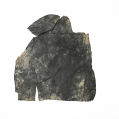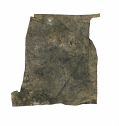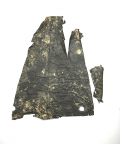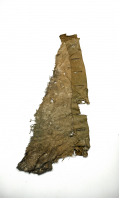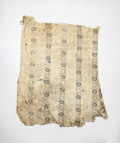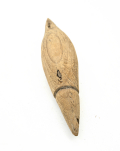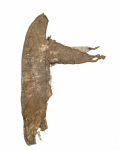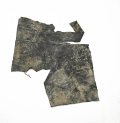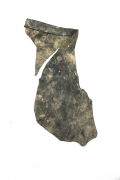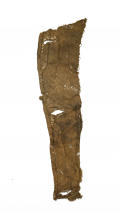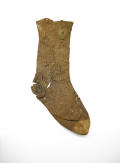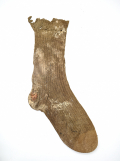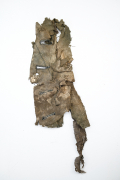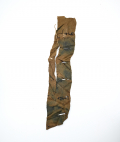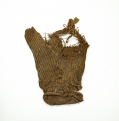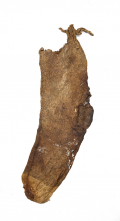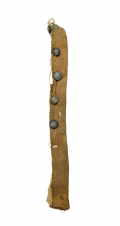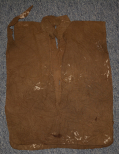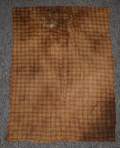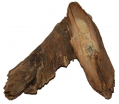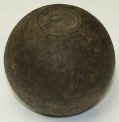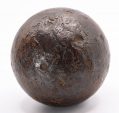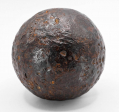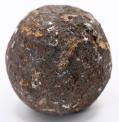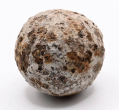site search
online catalog
Relics
Showing 151 to 200 out of 367
PIECE OF ARMY BLANKET FROM FORT PEMBINA, NORTH DAKOTA
This piece of a U.S. Army blanket comes from the excavations at Fort Pembina, ND, where wet, anaerobic soil conditions produced not only leather gear, but cloth in amazingly good condition. This shows… (1052-607). Learn More »
SCARCE CIVIL WAR PONCHO OR “GUM BLANKET” FRAGMENT
Civil War period ponchos and rubber blankets are extremely scarce despite being widely used and valued by troops in the field. They were so useful at home as to be used up by veterans and their… (1052-628). Learn More »
SCARCE CIVIL WAR INDIA RUBBER BLANKET OR PONCHO FRAGMENT
Excavated portion of a Civil War poncho or rubber blanket. This is a rough rectangle, preserving one edge with its binding intact and one of the brass grommets, with its diamond/square shaped… (1052-570). Learn More »
SCARCE CIVIL WAR INDIA RUBBER BLANKET OR PONCHO FRAGMENT
Excavated portion of a Civil War poncho or rubber blanket. This comes from the excavations at Fort Pembina in North Dakota, an army post garrisoned from 1870 to 1895. They were supplied at first with… (1052-568). Learn More »
CIVIL WAR FROCK COAT LAPEL FROM FORT PEMBINA, ND
This lapel comes from the left side of US army dress coat discarded by a soldier at Fort Pembina, ND, and was excavated in wet, anaerobic soil that has preserved leather and cloth in remarkable… (1052-588). Learn More »
PIECE OF PRIVATE PURCHASE SOLDIER’S SHIRT FORT PEMBINA, NORTH DAKOTA
Army issue shirts had little going for them in comfort and less in style. This is a fragment of a privately purchased shirt from the excavations at Fort Pembina, ND, garrisoned from 1870 to 1895. This… (1052-606). Learn More »
CARVED WOOD FROM FORT PEMBINA
At least one other similarly shaped piece of wood has come from the excavations at Fort Pembina, near the Red River in North Dakota. At first sight we guessed it was a wood arrow carved as for use as… (1052-637). Learn More »
CARVED WOOD FROM FORT PEMBINA
Excavated at Fort Pembina, near the Red River in North Dakota, this tapered wood cylinder is most likely a buoy or float from a fishing net, having grooves cut at either end for tying in place. Army… (1052-636). Learn More »
FISHING NET FLOAT OR BUOY FROM FORT PEMBINA
Excavated at Fort Pembina, near the Red River in North Dakota, this tapered wood cylinder is most likely a buoy or float from a fishing net, having grooves cut at either end for tying in place. Army… (1052-638). Learn More »
MODEL 1872 FATIGUE BLOUSE FRAGMENT: FORT PEMBINA
This appears to be the rollover collar and portion of the chest from a M1872 fatigue blouse. This was pleated nine-button blouse piped on the collar and cuff, made in lined and unlined versions, with… (1052-598). Learn More »
ATTRACTIVE WOOD CASE WITH RELICS FROM SHILOH, STONES RIVER, & CHICKAMAUGA
Here is a wood display case 6.75” x 5” with fine brown tone. Inside are three relics; one each from Shiloh, Chickamauga, and Stones River. At top is a fine Confederate Staff Officer’s button… (1235-59). Learn More »
DRILLED WOOD BLOCK FROM FORT PEMBINA
This comes from the excavations at Fort Pembina, ND, conducted on private property with the owner’s permission, and is in a remarkable state of preservation from the wet, anaerobic conditions of the… (1052-635). Learn More »
SCARCE CIVIL WAR PONCHO OR “GUM BLANKET” FRAGMENT
Civil War period ponchos and rubber blankets are extremely scarce despite being widely used and valued by troops in the field. They were so useful at home as to be used up by veterans and their… (1052-630). Learn More »
KEPI OR DRESS HAT STIFFENER FROM FORT PEMBINA
This leather disk seems to be the stiffener from inside the top of a hat, either a kepi or dress hat. It is circular and folded over on one side, black in color with gray and white stains, and comes… (1052-476). Learn More »
SCARCE CIVIL WAR PONCHO OR “GUM BLANKET” FRAGMENT
This scarce fragment comes from either a poncho or blanket (often referred to as “rubberized,” “gum,” or “painted” blankets.) The significant difference being the presence of slit for the… (1052-627). Learn More »
CIVIL WAR-INDIAN WAR UNIFORM COAT LAPEL FROM FORT PEMBINA
This strip of cloth shows three buttonholes indicating it is from the lapel of a coat and the spacing suggests it is from an army fatigue blouse. This comes from excavations at Fort Pembina, a small… (1052-614). Learn More »
INDIAN WAR SOLDIER’S SOCK FROM FORT PEMBINA, ND
This appears to be the 1877 pattern army sock, which was medium gray in color, had white toes, and the weave of the heel running parallel with the leg and nearly at a right angle to the foot. We show… (1052-594). Learn More »
INDIAN WAR SOLDIER’S SOCK FROM FORT PEMBINA, ND
This comes from the excavations at Fort Pembina, ND, and appears to be the 1877 pattern army sock, which was medium gray in color, had white toes, and the weave of the heel running parallel with the… (1052-593). Learn More »
CIVIL WAR-INDIAN WAR UNIFORM COAT LAPEL FROM FORT PEMBINA
This strip of cloth with four closely spaced button holes is likely the remnant of an army dress coat discarded after its useful days were done at Fort Pembina, a small frontier garrison in North… (1052-613). Learn More »
CIVIL WAR-INDIAN WAR UNIFORM LAPEL FROM FORT PEMBINA
This strip of cloth showing six buttonholes is likely the remnant of an army dress coat discarded after its useful days were done at Fort Pembina, a small frontier garrison in North Dakota, where wet,… (1052-612). Learn More »
SCARCE INDIAN WAR SOLDIER’S MITTEN FROM FORT PEMBINA, ND
This comes from the excavations at Fort Pembina, occupied 1870-1895, where cold weather in winter months might well be a concern. The army began issuing mittens in 1873. Before that men were left to… (1052-585). Learn More »
INDIAN WAR SOLDIER’S SOCK FROM FORT PEMBINA, ND
This comes from the excavations at Fort Pembina, ND, and appears to be the 1877 pattern army sock, which was medium gray in color, had white toes, and the weave of the heel running parallel with the… (1052-583). Learn More »
CIVIL WAR-INDIAN WAR UNIFORM COAT LAPEL FROM FORT PEMBINA
This lapel comes from a US army coat discarded by a soldier at Fort Pembina, ND, and still has five enlisted, general service eagle buttons in place. This comes from excavations in wet, anaerobic soil… (1052-565). Learn More »
SCARCE CIVIL WAR ARMY ISSUE SHOE, A.K.A. BROGAN OR BOOTTEE
This Civil War issue shoe is missing the vamp, but shows illustrates the typical construction of an issue brogan. This comes from a U.S. Army Indian War post established in 1870, a period in which the… (1052-542). Learn More »
SCARCE CIVIL WAR ARMY ISSUE BROGAN ALTERED TO A BARRACKS SHOE AT FORT PEMBINA
This Civil War army-issue shoe is in very good condition though excavated and easy to take for a barn or attic find. This was recovered at Fort Pembina, ND, a US army post established in 1870, where… (1052-287). Learn More »
US ISSUE MODEL 1872 SHOE, MAKER MARKED, POSSIBLY BY JOHN MUNDELL OF PHILADELPHIA
This army-issue was excavated at Fort Pembina, ND, established in 1870 and in operation to 1895. It was found on private property, with the owner’s permission, and is in good condition, a result of… (1052-492). Learn More »
EARLY INDIAN WAR ALTERED BARRACKS OR CAMP SHOE
This is an unusual Indian War soldier’s camp or barracks shoe from Fort Pembina, ND, a small U.S. army post from 1870 to 1895. The heel portion of the quarters was cut away, either to salvage the… (1052-288). Learn More »
CIVIL WAR ERA WORKSHIRT/SMOCK MADE FROM ALTERED SHIRT FORT PEMBINA
This is a simple shirt altered by a soldier at a frontier US Army fort for wear as smock to shield his uniform while on a work or fatigue detail and comes from excavations at Fort Pembina, North… (1052-649). Learn More »
CIVIL WAR ERA WORKSHIRT/SMOCK MADE FROM ALTERED SHIRT FORT PEMBINA
This is a simple shirt altered by a soldier at a frontier US Army fort for wear as smock to shield his uniform while on a work or fatigue detail and comes from excavations at Fort Pembina, North… (1052-648). Learn More »
RARE MARKED CIVIL WAR ARMY ISSUE SHOE
Civil War army-issue shoes were among the most essential things issued to a soldier and about the rarest of Civil War items to survive despite being made literally in the millions. They were cheaply… (1052-286). Learn More »
SCARCE INDIAN WAR US ARMY 1872 PATTERN SHOE ALTERED TO CAMP OR BARRACKS SHOE
New pattern shoes and boots were introduced in the U.S. Army in 1872 and in use until the 1880s with a minor change in 1876 to a longer tongue. These shoes improved upon Civil War issue patterns… (1052-286). Learn More »
CONFEDERATE TWO-PIECE “TONGUE AND WREATH” BELT PLATE, FOUND BY JOHN DUGGAN
This is the epitome of a Confederate belt buckle. This “tongue and wreath” sword belt buckle was recovered long ago by John Duggan. In near perfect excavated condition; perhaps just slightly… (490-6335). Learn More »
$2,500.00
ON HOLD
SILVER CONFEDERATE ID BADGE RECOVERED NEAR FALLING WATERS - GETTYSBURG POW
This silver badge is crescent shaped and meas. approx. 1.00 inch long. It is engraved around the edges with a linear decoration and engraved on its face is “SKIDS.” Reverse has the remains of a… (2024-29). Learn More »
“COLT’S PATENT” MOLD FOR .44 CAL. BULLETS PICTURED IN “ROUND BALL TO RIMFIRE, PART THREE”
Here is an iron bullet mold for Army revolvers (.44 caliber). Two cavity type; one round ball, one “new model” conical ball. Typical Civil War-era mold in good relic condition; surface heavily… (236-836). Learn More »
BRASS MOLD FOR .44 CAL. BULLETS PICTURED IN “ROUND BALL TO RIMFIRE, PART THREE”
Here is a brass bullet mold for Army revolvers (.44 caliber). Two cavity type; one round ball, one “old model” conical ball. Typical Civil War-era mold in good relic condition; brass shows dark… (236-837). Learn More »
BULLET IN WOOD – COLD HARBOR
Excavated remains of a tree with a bullet fired into it. The base and cavity of a typical Civil War Minie ball can be seen. Wood measures 6” long x 5”. Wood remains stable. Recovered from Cold… (2023-2994). Learn More »
4.52 INCH SPHERICAL SHELL WITH CONFEDERATE BORMAN FUSE, FOUND NEAR WEIKERT HOUSE – GEISELMAN COLLECTION
Here is a very nice 12-pounder spherical shell with a Confederate Borman fuse still intact. Lightly pitted, the shell measures 4.52 inches in diameter and weighs 7 pounds 14 ounces. Ralph Grove… (2023-3149). Learn More »
$2,295.00
ON HOLD
DUG MODEL 1816 HALL PATTERN BAYONET FROM FREDERICKSBURG
Bayonet has full length blade and socket with mortise. No markings are visible. Surfaces are rusted but have been coated with black paint. Item was recovered at Fredericksburg, VA. [ad]… (2023-1488). Learn More »
DUG PATTERN 1853 ENFIELD BAYONET FROM FREDERICKSBURG
Bayonet has full length blade and socket with mortise. Locking ring is frozen. No markings are visible. Surfaces are rusted but have been coated with clear lacquer. Item was recovered at… (2023-1490). Learn More »
2-LB SHOT RECOVERED FROM THE NAPOLEONIC WAR BATTLEFIELD OF HANAU -1813
Dug iron shot meas. approx. 2.00 inches in diameter and is in good relic condition. Item was dug in June of 1992 on the Hanau battlefield by a resident of Carlisle, Pennsylvania while serving in… (1202-11). Learn More »
4-LB SHOT RECOVERED FROM THE NAPOLEONIC WAR BATTLEFIELD OF HANAU -1813
Dug iron shot meas. approx. 2.25 inches in diameter and is in good relic condition. Item was dug on April 5, 1992 on the Hanau battlefield by a resident of Carlisle, Pennsylvania while serving in… (1202-12). Learn More »
CANISTER BALL RECOVERED FROM THE NAPOLEONIC WAR BATTLEFIELD OF HANAU -1813
Dug lead canister ball meas. approx. 1.00 inch in diameter and in good relic condition. Item was dug on the Hanau battlefield by a resident of Carlisle, Pennsylvania while serving in Germany with the… (1202-39). Learn More »
CANISTER BALL RECOVERED FROM THE NAPOLEONIC WAR BATTLEFIELD OF HANAU -1813
Dug lead canister ball meas. approx. 1.00 inch in diameter and in good relic condition. Item was dug on the Hanau battlefield by a resident of Carlisle, Pennsylvania while serving in Germany with the… (1202-40). Learn More »
DUG PATTERN 1854 AUSTRIAN BAYONET FROM FREDERICKSBURG
Bayonet has full length blade and socket with mortise. Locking ring is frozen. No markings are visible. Surfaces are rusted but have been coated with clear lacquer. Item was recovered at… (2023-1486). Learn More »
DUG PATTERN 1855 SOCKET BAYONET FROM FREDERICKSBURG
Bayonet has full length blade and socket with mortise. Locking ring is frozen. No markings are visible. Surfaces are rusted but have been coated with black paint. Blade has a slight bend to it. Item… (2023-1487). Learn More »
FRENCH CHASSEPOT BAYONET DUG ON THE FRANCO-PRUSSIAN WAR BATTLEFIELD OF WORTH FOUGHT IN AUGUST OF 1870
Item is a French Chassepot bayonet in good relic condition. Overall, the bayonet meas. approx. 27.00 inches long. The rusted blade looks to be near its full length and meas. 21.75 inches. Blade does… (1202-49). Learn More »
FRANCO-PRUSSIAN WAR NCO SWORD DUG ON THE 1870 BATTLEFIELD OF WORTH – UNIT MARKED
Item is a Prussian NCO sword in good relic condition. Overall the sword meas. approx. 22.50 inches. The rusted blade is full length and meas. 17.50 inches. Blade does exhibit some minor loss along the… (1202-48). Learn More »
PAIR OF CONTINENTAL SOLDIER’S ICE CREEPERS, CAMP ROBINSON’S FARM
Offered here is an excavated pair of iron “ice creepers.” A scarce item, these strips of iron feature four small spikes bent downward and loops bent upward. These “creepers” were tied to the… (236-756). Learn More »
LEAD SABOT FROM A KRUPP SHELL DUG ON THE BATTLEFIELD OF WORTH – AUGUST 1870
Folded piece of lead sabot meas. approx. 2.25 x 4.00 inches with three visible driving bands. Item was recovered on the August 6, 1870 battlefield of Worth. The Battle of Wörth, also known as the… (1202-59). Learn More »
RUSSIAN FORT ROSS (CALIFORNIA) DISPLAY
Presented in a 9” x 6” wood display case is a round ball and a Russian-Siberian coin with labels. The .54 caliber lead rifle ball was recovered at the site of Fort Ross. This was a Russian fur… (236-794). Learn More »
Showing 151 to 200 out of 367
Most Popular
Historical Firearms Stolen From The National Civil War Museum In Harrisburg, Pa »
Theft From Gravesite Of Gen. John Reynolds »
Selection Of Unframed Prints By Don Troiani »
Fine Condition Brass Infantry Bugle Insignia »
British Imported, Confederate Used Bayonet »
Scarce New Model 1865 Sharps Still In Percussion Near Factory New »
featured item
IMPORT MODEL 1850 CIVIL WAR FIELD & STAFF OFFICER’S SWORD ID’D TO COL. RICHARD M. CORWINE, MEMBER OF GENERAL FREMONT’S STAFF
Original Civil War Model 1850 Field & Staff officer’s sword in nice condition complete with its metal scabbard. Sword is unmarked and is no doubt an import item. It is identified by a presentation inscription to R. M. Corwine, Aide-de-camp to… (870-157). Learn More »
site search
Upcoming Events
May 16 - 18: N-SSA Spring Nationals, Fort Shenandoah, Winchester, VA Learn More »




